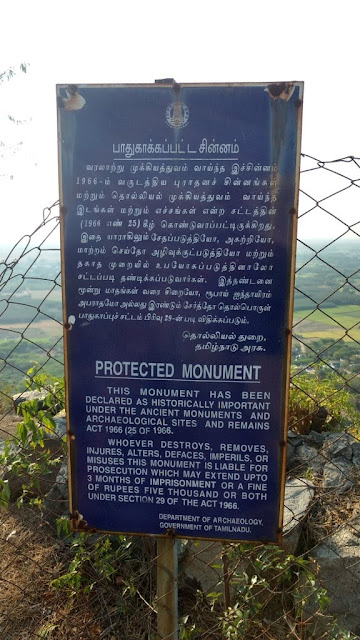Perumukkal – History
The recorded history of
Perumukkal dates back six millennia. Historical landmarks in Perumukkal include
the 4000 B.C.E. Petroglyph, the 7th century
Mukthialeeswarar Temple, the ruined Kamatchiamman temple, and an ancient Fort.
This temple, which had
originally been built in brick, was converted into a stone temple during the
period of Vikrama Chola (1118-35 CE). The donations made by the Cholas,
Pandyas, Sambuvarayars, Kadavarayas, Vijayanagara rulers have been recorded in
more than 60 inscriptions found on the temple walls. Oldest inscription found
in this Temple belongs to Uthama Chola. Most of the other inscriptions belongs
to Kulotunga Chola and Vikrama Chola. The Temple was reconstructed in granite
by Vikrama Chola.
This Village was called as
Jayamkonda Chozha Mandalathu Oyma Naadana Vijaya Rajendra Valanaatu
Perumukillana Gangai Konda Nallur during Later Cholas Period. The Village might
be renamed during Rajendra Chola I, remembering his Gangetic expedition. Idol
of Kakku Nayagan, who has done many donations for the reconstruction, Idol of
Periyan Thiruvanaana Sirthondan, chief architect and Idol of Thiru
Chitrambalamudaiyan Anbarkkarasu Bhattan can be found in the Temple premises.
There is a unique inscription
belongs to Chola period about open tender for Temple renovations can be seen
here. Another inscription talks about group worship called Aramiranga Naatu
Santhi for the welfare of country. There is a belief that Nandasiriyan, a
renowned Ajivika Saint contemporary to the famous Sangam period Pandya emperor
Thalaiyaalanganathu Seru Vendra Neduchezhiyan Pandiyan, attained Mukthi here.
Hence Lord Shiva of this Temple is called as Mukthialeeswarar. Also, Mailam Pommapura Aadheenam Bala Siddhar Balayogi
also performed penance on Lord Mukthialeeswarar here.
In 1906 AD, Sri Chandrasekarar,
the 66th Peedathipathi of Shankara Madam was performing his Chaturmasya Viradha
in Mukthialeeswarar Temple. A Child named Swaminathan came to worship Kanchi
Shankaracharya along with his parents. Kanchi Shankaracharya impressed with his
devotion and knowledge. Kanchi Shankaracharya nominated that Kid as 68th
Peedathipathi of Shankara Madam in few years. He is none other than
Chandrasekharendra Saraswathi Swamigal.
During Nawab period, a
representative of Arcot Nawab called Hyder Ali Khan ruled over the region.
Nawab Chanda Sahib Son marriage was to be held in Puducherry. Nawab instructed
his representative of Perumukkal to invite French Governor for the marriage.
This incident was noted by Ananda Ranga Pillai, Dubash of French East India
Company. Hyder Ali Khan was in friendly terms with French.
During the British invasion of
Puducherry, British captured Perumukkal Fort from Hyder Ali Khan in 1760 AD.
Hyder Ali of Mysore Kingdom captured Perumukkal from British in 1780 AD.
British recaptured Perumukkal in 1783 AD. Tippu Sultan, son of Hyder Ali,
captured again in 1790 AD. British again recaptured within few years. Due to
continuous battels and invasions, the fort was completely destroyed. Only
remains of few fort walls and Temples can be seen now.
A cave found on the western
hillock is called Seetha Cave. There are petroglyphs found in this cave. This
is the only petroglyph ever discovered in Tamil
Nadu and is one of the four found in India. These petroglyphs
are similar to the Egyptian Hieroglyphics letters
and hence are believed to be from around 4000 BCE. However, some researchers
date these to the megalithic age. There are also some Tamil Vattezhuthu
inscriptions dating back to 7th century A.D in this cave.







































